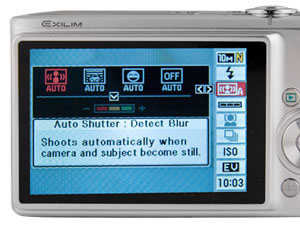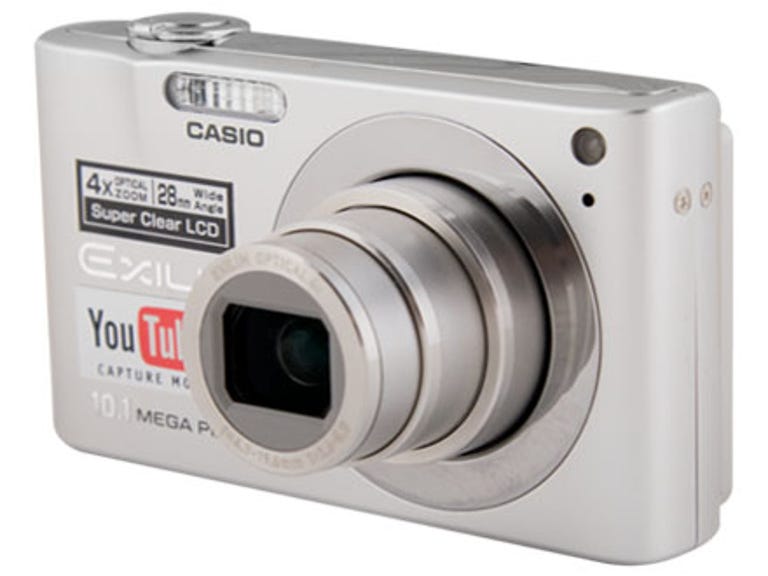 Why You Can Trust CNET
Why You Can Trust CNET Casio Exilim EX-Z100 review: Casio Exilim EX-Z100
It's hard to find fault with Casio cameras these days. The Casio Exilim EX-Z100 makes for another compact success. From its understated style and large screen to its accessible controls and useful features, this snapper is a study in what the compact camera can be
We first saw the Casio Exilim EX-Z100 at CES 2008. Even alongside the staggering EX-F1, the assortment of new Exilim cameras seemed on first impression to build on Casio's recent high calibre of compacts. The super-skinny EX-S10 bore that out, and we put the EX-Z100 through its paces to see if this is another success for Casio. The price is certainly right: it's available online now for around £160.
The Good
The Bad
The Bottom Line
Design
To our eyes, the EX-Z100 looks fantastic. At the risk of overstating a fairly standard design, somehow the rounded-off edges, silver accents and, most of all, the ridge under the zoom rocker drip with understated class. The shiny bits are real fingerprint magnets, however.
The sturdy metal frame comes in pink, silver, blue and gold. It's pocket-friendly, but with a decent weight to it. The metal buttons are laid out in the standard pattern, although we continue to be unconvinced by Casio's policy of having separate playback and shooting button instead of one toggle.

The EX-Z100 includes a number of different autofocus features, including face detection, all available from the handy on-screen sidebar
We did like the dedicated video record button. This finally makes Casio's YouTube mode into a viable proposition as it gets rid of the menu-sifting required on older models.
The screen measures a large 69mm (2.7-inch) diagonally. The black bezel detracts from the size slightly, but we were impressed by the above-average 230,160 dots making up the onscreen image.
Features
The lens is the big draw with the Z100. It has a 35mm equivalent focal length of 28mm at the wide angle. This is pleasingly wide for a compact camera. As well as being wider, the lens is also slightly longer than the average with a 4x optical zoom.
Face detection is augmented by smile detection, which we're not sold on, but some people may find it useful. The system also checks for motion blur and can snap an image when movement stops. When taking self-portraits, the camera can check for your face in the frame so you don't cut off your forehead or chin.
All the Casio scene modes are present. Known as best shot modes, they range from the useful -- portrait, night mode and so on -- to the impractical, like text and whiteboard. In auto best shot mode, the camera senses the environment and adjusts shooting settings accordingly. Although you don't get manual control as such, the on-screen Casio sidebar puts the main shooting options at your fingertips.
YouTube mode benefits from the discrete button, which shoots H.264 video in 16:9 aspect ratio, which can be easily uploaded to YouTube via the bundled uploader software, a regular Exilim feature.
Performance
Start-up is respectable. The autofocus is quick even when finding faces, and rarely needs to hunt around, even in low light. The automatic white balance is also capable, although occasional confusion over indoor light sources may make it worth setting up a shortcut to the manual white balance option to your buttons.
There are three continuous modes. The normal mode shoots full-resolution 10-megapixel images and manages 1 shot every two seconds. The high speed mode manages a much more creditable 4 frames per second, but only at 2 megapixels. A compromise between speed and resolution might have been preferable, but that's a minor quibble. The continuous flash mode is misleadingly named, as it's actually just one flash with three pictures taken.
This crop from a test shot shows the difference in noise levels at ISO 400, on the left, and ISO 800 on the right
Images look crisp and sharp. There's a warmth to colours, especially portraits, and we were happy with the exposure metering. Some of the common compact camera problems appear, like a tendency to blow out highlights in high contrast shots. But purple fringing is barely noticeable, and noise is present but not too intrusive even up to ISO 400. In low light things and at higher ISO speeds, noise is a problem, but this is to be expected.
Conclusion
The Exilim EX-Z100 is another success for Casio. Its understated style complements accessible controls and a large screen, while an above-average lens and useful features take care of the business end. Those looking for more manual control might prefer the Samsung L830, while those seeking better low-light performance could go for the Fujifilm FinePix F50fd. But really, we just can't fault Casio these days.
Edited by Jason Jenkins
Additional editing by Shannon Doubleday


